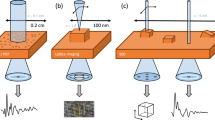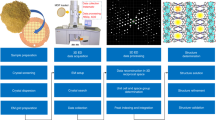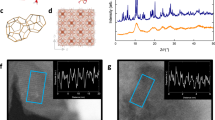Abstract
Defect engineering of metal–organic frameworks (MOFs) offers promising opportunities for tailoring their properties to specific functions and applications. However, determining the structures of defects in MOFs—either point defects or extended ones—has proved challenging owing to the difficulty of directly probing local structures in these typically fragile crystals. Here we report the real-space observation, with sub-unit-cell resolution, of structural defects in the catalytic MOF UiO-66 using a combination of low-dose transmission electron microscopy and electron crystallography. Ordered ‘missing linker’ and ‘missing cluster’ defects were found to coexist. The missing-linker defects, reconstructed three-dimensionally with high precision, were attributed to terminating formate groups. The crystallization of the MOF was found to undergo an Ostwald ripening process, during which the defects also evolve: on prolonged crystallization, only the missing-linker defects remained. These observations were rationalized through density functional theory calculations. Finally, the missing-cluster defects were shown to be more catalytically active than their missing-linker counterparts for the isomerization of glucose to fructose.
This is a preview of subscription content, access via your institution
Access options
Access Nature and 54 other Nature Portfolio journals
Get Nature+, our best-value online-access subscription
$29.99 / 30 days
cancel any time
Subscribe to this journal
Receive 12 print issues and online access
$259.00 per year
only $21.58 per issue
Buy this article
- Purchase on Springer Link
- Instant access to full article PDF
Prices may be subject to local taxes which are calculated during checkout





Similar content being viewed by others
Data availability
The authors declare that all the data supporting the findings of this study are available within the paper and the Supplementary Information, and/or from the authors upon reasonable request.
References
Li, H., Eddaoudi, M., O’Keeffe, M. & Yaghi, O. M. Design and synthesis of an exceptionally stable and highly porous metal–organic framework. Nature 402, 276–279 (1999).
Eddaoudi, M. et al. Systematic design of pore size and functionality in isoreticular MOFs and their application in methane storage. Science 295, 469–472 (2002).
Yaghi, O. M. et al. Reticular synthesis and the design of new materials. Nature 423, 705–714 (2003).
Horike, S., Shimomura, S. & Kitagawa, S. Soft porous crystals. Nat. Chem. 1, 695–704 (2009).
Eddaoudi, M., Sava, D. F., Eubank, J. F., Adil, K. & Guillerm, V. Zeolite-like metal–organic frameworks (ZMOFs): design, synthesis and properties. Chem. Soc. Rev. 44, 228–249 (2015).
Li, J.-R., Kuppler, R. J. & Zhou, H.-C. Selective gas adsorption and separation in metal–organic frameworks. Chem. Soc. Rev. 38, 1477–1504 (2009).
Férey, G. et al. A chromium terephthalate-based solid with unusually large pore volumes and surface area. Science 309, 2040–2042 (2005).
Chui, S. S.-Y., Lo, S. M.-F., Charmant, J. P. H., Orpen, A. G. & Williams, I. D. A chemically functionalizable nanoporous material [Cu3(TMA)2(H2O)3]n. Science 283, 1148–1150 (1999).
Dissegna, S., Epp, K., Heinz, W. R., Kieslich, G. & Fischer, R. A. Defective metal–organic frameworks. Adv. Mater. 30, 1704501 (2018).
Fang, Z., Bueken, B., De Vos, D. E. & Fischer, R. A. Defect-engineered metal–organic frameworks. Angew. Chem. Int. Ed. 54, 7234–7254 (2015).
Bennett, T. D., Cheetham, A. K., Fuchs, A. H. & Coudert, F.-X. Interplay between defects, disorder and flexibility in metal–organic frameworks. Nat. Chem. 9, 11–16 (2017).
Lee, J. et al. Metal–organic framework materials as catalysts. Chem. Soc. Rev. 38, 1450–1459 (2009).
Sumida, K. et al. Carbon dioxide capture in metal–organic frameworks. Chem. Rev. 112, 724–781 (2012).
Shoaee, M., Agger, J. R., Anderson, M. W. & Attfield, M. P. Crystal form, defects and growth of the metal organic framework HKUST-1 revealed by atomic force microscopy. CrystEngComm 10, 646–648 (2008).
Ling, S. & Slater, B. Dynamic acidity in defective UiO-66. Chem. Sci. 7, 4706–4712 (2016).
Cavka, J. H. et al. A new zirconium inorganic building brick forming metal–organic frameworks with exceptional stability. J. Am. Chem. Soc. 130, 13850–13851 (2008).
Jakobsen, S. et al. Structural determination of a highly stable metal–organic framework with possible application to interim radioactive waste scavenging: Hf-UiO-66. Phys. Rev. B 86, 125429 (2012).
Falaise, C. et al. Three-dimensional MOF-type architectures with tetravalent uranium hexanuclear motifs (U6O8). Chem. Eur. J. 19, 5324–5331 (2013).
Shearer, G. C. et al. Defect engineering: tuning the porosity and composition of the metal–organic framework UiO-66 via modulated mynthesis. Chem. Mater. 28, 3749–3761 (2016).
Shearer, G. C. et al. Tuned to perfection: ironing out the defects in metal–organic framework UiO-66. Chem. Mater. 26, 4068–4071 (2014).
Valenzano, L. et al. Disclosing the complex structure of UiO-66 metal–organic framework: a synergic combination of experiment and theory. Chem. Mater. 23, 1700–1718 (2011).
Wu, H. et al. Unusual and highly tunable missing-linker defects in zirconium metal–organic framework UiO-66 and their important effects on gas adsorption. J. Am. Chem. Soc. 135, 10525–10532 (2013).
Øien, S. et al. Detailed structure analysis of atomic positions and defects in zirconium metal–organic frameworks. Cryst. Growth Des. 14, 5370–5372 (2014).
Trickett, C. A. et al. Definitive molecular level characterization of defects in UiO-66 crystals. Angew. Chem. Int. Ed. 54, 11162–11167 (2015).
Cliffe, M. J. et al. Correlated defect nanoregions in a metal–organic framework. Nat. Commun. 5, 4176 (2014).
Schrimpf, W. et al. Chemical diversity in a metal–organic framework revealed by fluorescence lifetime imaging. Nat. Commun. 9, 1647 (2018).
Hashimoto, A., Suenaga, K., Gloter, A., Urita, K. & Iijima, S. Direct evidence for atomic defects in graphene layers. Nature 430, 870–873 (2004).
Platero-Prats, A. E. et al. Bridging zirconia nodes within a metal–organic framework via catalytic Ni-hydroxo clusters to form heterobimetallic nanowires. J. Am. Chem. Soc. 139, 10410–10418 (2017).
Mehdi, B. L. et al. Low-dose and in-painting methods for (near) atomic resolution STEM imaging of metal organic frameworks (MOFs). Microsc. Microanal. 23, 1804–1805 (2017).
Mayoral, A., Sanchez-Sanchez, M., Alfayate, A., Perez-Pariente, J. & Diaz, I. Atomic observations of microporous materials highly unstable under the electron beam: the cases of Ti-doped AlPO4-5 and Zn-MOF-74. ChemCatChem 7, 3719–3724 (2015).
Leus, K. et al. Atomic layer deposition of Pt nanoparticles within the cages of MIL-101: a mild and recyclable hydrogenation catalyst. Nanomaterials 6, 45 (2016).
Zhu, Y. et al. Unravelling surface and interfacial structures of a metal–organic framework by transmission electron microscopy. Nat. Mater. 16, 532–537 (2017).
Zhang, D. et al. Atomic-resolution transmission electron microscopy of electron beam-sensitive crystalline materials. Science 359, 675–679 (2018).
Sakamoto, Y. et al. Direct imaging of the pores and cages of three-dimensional mesoporous materials. Nature 408, 449–453 (2000).
Han, Y. et al. A tri-continuous mesoporous material with a silica pore wall following a hexagonal minimal surface. Nat. Chem. 1, 123–127 (2009).
Vandichel, M. et al. Active site engineering in UiO-66 type metal–organic frameworks by intentional creation of defects: a theoretical rationalization. CrystEngComm 17, 395–406 (2015).
Taddei, M., Wakeham, R. J., Koutsianos, A., Andreoli, E. & Barron, A. R. Post-synthetic ligand exchange in zirconium-based metal–organic frameworks: beware of the defects! Angew. Chem. Int. Ed. 57, 11706–11710 (2018).
Vermoortele, F. et al. Synthesis modulation as a tool to increase the catalytic activity of metal–organic frameworks: the unique case of UiO-66(Zr). J. Am. Chem. Soc. 135, 11465–11468 (2013).
Korzyński, M. D., Consoli, D. F., Zhang, S., Román-Leshkov, Y. & Dincă, M. Activation of methyltrioxorhenium for olefin metathesis in a zirconium-based metal–organic framework. J. Am. Chem. Soc. 140, 6956–6960 (2018).
Liu, Y., Klet, R. C., Hupp, J. T. & Farha, O. Probing the correlations between the defects in metal–organic frameworks and their catalytic activity by an epoxide ring-opening reaction. Chem. Commun. 52, 7806–7809 (2016).
De Mello, M. D. & Tsapatsis, M. Selective glucose-to-fructose isomerization over modified zirconium UiO-66 in alcohol media. ChemCatChem 10, 2417–2423 (2018).
Sholl, D. S. & Lively, R. P. Defects in metal–organic frameworks: challenge or opportunity? J. Phys. Chem. Lett. 6, 3437–3444 (2015).
Park, J., Howe, J. D. & Sholl, D. S. How reproducible are isotherm measurements in metal–organic frameworks? Chem. Mater. 29, 10487–10495 (2017).
Jones, J. T. A. et al. Modular and predictable assembly of porous organic molecular crystals. Nature 474, 367–371 (2011).
Acknowledgements
This research was supported by Competitive Center Funds (FCC/1/1972-19) to Y.H. and M.E. from King Abdullah University of Science and Technology. This research used resources of the Core Labs of King Abdullah University of Science and Technology. Yi.Z. acknowledges financial support from the National Natural Science Foundation of China (21771161) and the Thousand Talents Program for Distinguished Young Scholars. S.L. and B.S. are thankful to the Materials Chemistry Consortium (EPSRC: EP/L000202) for provision of computer time on ARCHER UK National Supercomputing Service. B.S. acknowledges the Royal Society for financial support through an industry fellowship (F160062). The authors acknowledge helpful discussions with A. Goodwin, M. Cliffe and G. Shearer.
Author information
Authors and Affiliations
Contributions
Y.H., D.Z. and M.E. conceived and designed the experiments. L.L. acquired the low-dose high-resolution HRTEM images. Z.C., J.W., Y.B. and K.A. designed and synthesized MOF samples. Z.C., J.W. and Y.B. performed X-ray diffraction and N2 adsorption characterizations. L.L., D.Z., Yi.Z. and Y.H. processed and analysed the HRTEM images. D.Z. solved the 3D structure of the missing-linker defect. S.L. and B.S. performed theoretical calculations. J.W., Yu.Z. and K.-W.H. designed and performed the catalytic reactions. Y.H., D.Z., M.E., S.L. and B.S. wrote the manuscript and all authors commented on the manuscript.
Corresponding authors
Ethics declarations
Competing interests
The authors declare no competing interests.
Additional information
Publisher’s note: Springer Nature remains neutral with regard to jurisdictional claims in published maps and institutional affiliations.
Supplementary information
Supplementary Information
Methods; Supplementary Figs. 1–16; Supplementary Tables 1–5; Supplementary refs. 1–14
Crystallographic data
Atomic coordinates of optimised fcu structure
Crystallographic data
Atomic coordinates of optimised bcu structure
Crystallographic data
Atomic coordinates of optimised reo structure
Crystallographic data
Atomic coordinates of optimised scu structure
Rights and permissions
About this article
Cite this article
Liu, L., Chen, Z., Wang, J. et al. Imaging defects and their evolution in a metal–organic framework at sub-unit-cell resolution. Nat. Chem. 11, 622–628 (2019). https://doi.org/10.1038/s41557-019-0263-4
Received:
Accepted:
Published:
Issue Date:
DOI: https://doi.org/10.1038/s41557-019-0263-4
This article is cited by
-
Ultrastable ceramic-based metal–organic framework membranes with missing linkers for robust desalination
Nature Water (2024)
-
Production of eco friendly DME fuel over sonochemically synthesized UiO66 catalyst
Scientific Reports (2024)
-
Non-classical crystallization in soft and organic materials
Nature Reviews Materials (2024)
-
Highly defective ultra-small tetravalent MOF nanocrystals
Nature Communications (2024)
-
Solar-assisted photocatalytic water splitting using defective UiO-66 solids from modulated synthesis
Nano Research (2024)



